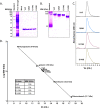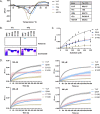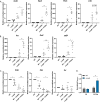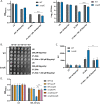Functional Characterization of Salmonella Typhimurium Encoded YciF, a Domain of Unknown Function (DUF892) Family Protein, and Its Role in Protection during Bile and Oxidative Stress
- PMID: 37367303
- PMCID: PMC10367587
- DOI: 10.1128/jb.00059-23
Functional Characterization of Salmonella Typhimurium Encoded YciF, a Domain of Unknown Function (DUF892) Family Protein, and Its Role in Protection during Bile and Oxidative Stress
Abstract
YciF (STM14_2092) is a member of the domain of unknown function (DUF892) family. It is an uncharacterized protein involved in stress responses in Salmonella Typhimurium. In this study, we investigated the significance of YciF and its DUF892 domain during bile and oxidative stress responses of S. Typhimurium. Purified wild-type YciF forms higher order oligomers, binds to iron, and displays ferroxidase activity. Studies on the site-specific mutants revealed that the ferroxidase activity of YciF is dependent on the two metal binding sites present within the DUF892 domain. Transcriptional analysis displayed that the ΔcspE strain, which has compromised expression of YciF, encounters iron toxicity due to dysregulation of iron homeostasis in the presence of bile. Utilizing this observation, we demonstrate that the bile mediated iron toxicity in ΔcspE causes lethality, primarily through the generation of reactive oxygen species (ROS). Expression of wild-type YciF, but not the three mutants of the DUF892 domain, in ΔcspE alleviate ROS in the presence of bile. Our results establish the role of YciF as a ferroxidase that can sequester excess iron in the cellular milieu to counter ROS-associated cell death. This is the first report of biochemical and functional characterization of a member of the DUF892 family. IMPORTANCE The DUF892 domain has a wide taxonomic distribution encompassing several bacterial pathogens. This domain belongs to the ferritin-like superfamily; however, it has not been biochemically and functionally characterized. This is the first report of characterization of a member of this family. In this study, we demonstrate that S. Typhimurium YciF is an iron binding protein with ferroxidase activity, which is dependent on the metal binding sites present within the DUF892 domain. YciF combats iron toxicity and oxidative damage caused due to exposure to bile. The functional characterization of YciF delineates the significance of the DUF892 domain in bacteria. In addition, our studies on S. Typhimurium bile stress response divulged the importance of comprehensive iron homeostasis and ROS in bacteria.
Keywords: DUF892 member; Salmonella; YciF; bile; biochemistry; metal binding; reactive oxygen species; stress proteins; stress response.
Conflict of interest statement
The authors declare no conflict of interest.
Figures







Similar articles
-
Interplay of cold shock protein E with an uncharacterized protein, YciF, lowers porin expression and enhances bile resistance in Salmonella Typhimurium.J Biol Chem. 2019 Jun 7;294(23):9084-9099. doi: 10.1074/jbc.RA119.008209. Epub 2019 Apr 16. J Biol Chem. 2019. PMID: 30992363 Free PMC article.
-
Global transcriptome analysis reveals Salmonella Typhimurium employs nitrate metabolism to combat bile stress.FEBS Lett. 2024 Jul;598(13):1605-1619. doi: 10.1002/1873-3468.14853. Epub 2024 Mar 19. FEBS Lett. 2024. PMID: 38503554
-
Linearized Siderophore Products Secreted via MacAB Efflux Pump Protect Salmonella enterica Serovar Typhimurium from Oxidative Stress.mBio. 2020 May 5;11(3):e00528-20. doi: 10.1128/mBio.00528-20. mBio. 2020. PMID: 32371597 Free PMC article.
-
The ins and outs of bacterial iron metabolism.Mol Microbiol. 2014 Aug;93(4):609-16. doi: 10.1111/mmi.12709. Epub 2014 Jul 22. Mol Microbiol. 2014. PMID: 25040830 Free PMC article. Review.
-
Iron homeostasis and management of oxidative stress response in bacteria.Metallomics. 2011 Jun;3(6):540-9. doi: 10.1039/c1mt00022e. Epub 2011 May 13. Metallomics. 2011. PMID: 21566833 Review.
References
-
- Majowicz SE, Musto J, Scallan E, Angulo FJ, Kirk M, O'Brien SJ, Jones TF, Fazil A, Hoekstra RM, International Collaboration on Enteric Disease 'Burden of Illness' Studies . 2010. The global burden of nontyphoidal Salmonella gastroenteritis. Clin Infect Dis 50:882–889. doi:10.1086/650733. - DOI - PubMed
-
- Wang X, Biswas S, Paudyal N, Pan H, Li X, Fang W, Yue M. 2019. Antibiotic resistance in Salmonella typhimurium isolates recovered from the food chain through national antimicrobial resistance monitoring system between 1996 and 2016. Front Microbiol 10:985. doi:10.3389/fmicb.2019.00985. - DOI - PMC - PubMed
Publication types
MeSH terms
Substances
LinkOut - more resources
Full Text Sources

